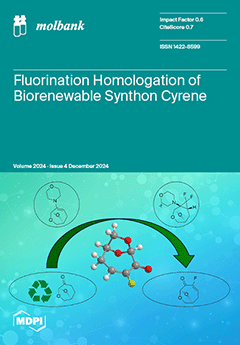The title compound,
trans-11-(3,4-Dimethoxyphenyl)-2,3,8,9-tetramethoxy-6-oxo-11,12-dihydro-6
H-dibenzo[
c,h]chromene-12-carboxylic acid (
4)
, was synthesized for the first time via a two-step protocol from 3,4-dimethoxyhomophthalic anhydride (
1) and 3,4-dimethoxybenzaldehyde (DMBA). In the first step,
1 reacts with DMBA to give
[...] Read more.
The title compound,
trans-11-(3,4-Dimethoxyphenyl)-2,3,8,9-tetramethoxy-6-oxo-11,12-dihydro-6
H-dibenzo[
c,h]chromene-12-carboxylic acid (
4)
, was synthesized for the first time via a two-step protocol from 3,4-dimethoxyhomophthalic anhydride (
1) and 3,4-dimethoxybenzaldehyde (DMBA). In the first step,
1 reacts with DMBA to give
trans-3-(3,4-dimethoxyphenyl)-6,7-dimethoxy-1-oxo-3,4-dihydro-1
H-2-benzopyran-4-carboxylic acid (
2), which further reacts with two additional equivalents of
1 to give
4. Compound
4 was characterized by means of spectral methods—
1H-,
13C-, DEPT-135-NMR, and HRMS.
Full article





